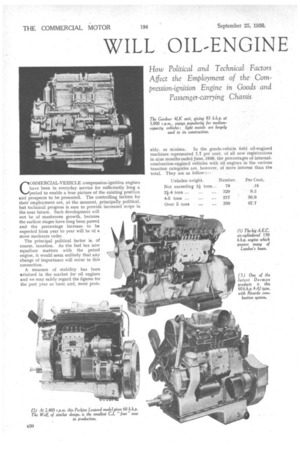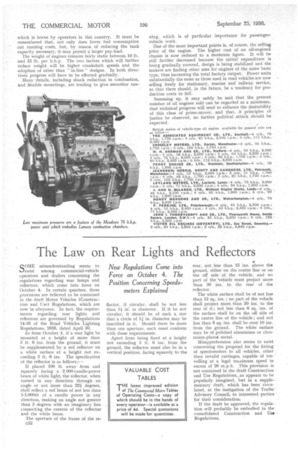WILL OIL-ENGINE PROGRESS CONTINUE?
Page 76

Page 77

Page 78

If you've noticed an error in this article please click here to report it so we can fix it.
How Political and Technical Factors Affect the Employment of the Cornpression-ignition Engine in Goods and Passenger-carrying Chassis COMMERCIAL-VEHICLE compression-ignition engines have been in everyday service for sufficiently long a period to enable a true picture of the existing position and prospects to be presented. The controlling factors for their employment are, at the moment, principally political, but technical progress is sure to provide increased scope in the near future. Such development will not be of mushroom growth, because the earliest stages have long been passed and the percentage increase . to be expected from year to year will be of a more moderate order.
The principal political factor is, of course, taxation. As the fuel tax now equalizes matters with the petrol engine, it would seem unlikely that any change of importance will occur in this connection.
A measure of stability has been attained in the market for oil engines and we may safely regard the figures for the past year as basic and, most prob. ably, as minima. In the goods-vehicle field oil-engined machines represented 1.7 per cent, of all new registrations in nine months ended June, 1936; the percentages of internalcombustion-engined vehicles with oil engines in the various taxation categories are, however, of more interest than the total. They are as follow :—
In the passenger-vehicle category. 52.5 per cent, of all new registrations in -the same period had oil engines, the sectional. figures being as follow
The foregoing figures show that the present demand is for Units for the larger types of chassis and for machines covering considerable mileages. As, however, many of the goods vehicles of below 2i tons unladen weight cover long distances in the course of a year, there is good scope for the small oil engine of three or four cylinders, costing but little more than the -petrol engine.
As the present restrictive policy of the authorities, in the interests of the railways, more or less -limits the sale of new vehicles to those for replacement purposes, plus a small number for taking the place of the obsolete tram and horse, we may expect the volume of the home market for road-transport. engines to remain reasonably constant, but the most likely factorsito increase the demand are the availability of cheaper and smaller engines and a general improvement in trade.
In the matter of the conversion of existing chassis to oilengine power, little can be expected in point of numbers in the goods-vehicle field at home, but the possibilities for passenger vehicles are brighter, as witness the 175 vehicles to be re-engined for Glasgow Corporation.
Overseas prospects are varied, but, on the whole, good. Prejudice is being overcome by practical experience and, in many countries, the incentive provided by the ability to effect economies under present fiscal conditions is more pronounced than in this country.
As to technical progress, which will ultimately have the
effect of increasing sales, it is, in the first instance; as well to pay attention to the sizes of unit that are at present on the market.The popular four-cylindered engine is available in sizes from 21 litres upwards, giving. 45
. . 2,500 r.p.m., whilst "sixes" range from 4.7 litres (71 b.h.p. at 2,200 r.p.m.) upwards; for light vans there is a 1-litre two-cylindered engine, giving20 b.h.p. at 2,800 r.p.m.
In the earlier years of the oilengine movement, all makers made a strong effort to attain a standard of reliability at -least as good as that of the petrol unit. That _ satisfactory state has now been reached and, .in some instances, surpassed.. The next common objective is to reduce fuel consumption.
At the present time, important steps are being taken in this direction. One leading maker is offering a directinjection engine as optional to a separate combustionchamber type, on account of the lower fuel consumption possible ; another will shortly announce a direct-injection engine in place of the two-cell type previously .built in the same works, whilst a third has, by detail alterations to the injeCtion and combustion system, reduced specific fuel consumption. Yet another is making material modifications to its design, with the same object in view. On the whole. British-built engines are rather more economical than those on the Continent, hut we are still progressing, 'spurred on by the heavy burden of taxation which is borne by operators in this country. It must be remembered that, not only does lower fuel consumption cut running costs, but, by reason of reducing the tank capacity necessary, it-may permit a larger pay-load.
The weight of engines remains fairly static between 10 lb. and 15 lb. per b.h.p. The two factors which will further reduce weight will be higher crankshaft speeds and the adoption of other than in-line" designs. In both directions progress will have to be effected gradually.
Many 'details, including shock reduction in combustion, and flexible mountings, are tending to give smoother run fling, which is of particular importance for passengervehicle work.
One of the most important points is, of course, the selling, price of the engine. The higher cost of an oil-engined chassis is now reduced to a moderate figure. It will be still further decreased because the initial expenditure is being gradually covered, design is being stabilized and the makers are funding other uses for engines of the same basic type, thus increasing the total factory output. Power units substantially the same as those used in road vehicles are now selling freely for stationary, marine and 'railway, service, so that there should, in the future, be a tendency for pro duction costs to fall. • Summing up, it may safely be said that the present number of oil engines sold can be regarded as a minimum, that technical progress will tend to enhance the desirability of this class of prime-mover, and that, if principles of justice be observed, no further political attack should be expected.
British makes of vehicle-type oil engine available for general sale are as follow:
THE ASSOCIATED EQUIPMENT CO., LTD., Southall.-4 cyls., 70 b.h.p., 1,750 r.p.m.; 4 cyls., 85 b.h.p., 2,040 r.p.m.; 6 cyls., 115 b.h.p., 2,400 r.p.m. CROSSLEY MOTORS, LTD., Gorton, Manchester.-4 cyls„ 66 b.h.p., 1,700 r.p.m.; 6 cyls., 100 b.h.p., 1,700 spin. W. H. DORMAN AND CO.' LTD„ Stafford.-4 cyls., 50 b.h.p., 2,500 r.p.m.; 4 cyls., 58 b.h.p., 2,000 r.p.m.; 4 cyls., 60 b.h.p., 2,200 r.p.m.; 4 cyls., 72 b.h.p., 2,000 r.p.m.; 4 cyls., 89 b.h.p., 1,700 Limn.; 6 cyls., 90 b.h.p., 2,400 r.p.m.; 6 cyls., 112 b.h.p., 2,000 r.p.m. FERRY ENGINE CO., LTD., Woolston, Southampton.-4 cyls., 50 b.h.p., 1,800 Loin. (GARDNER) NORRIS, HENTY AND GARDNERS, LTD., Patricroft, Manchester.-4 cyls., 53 b.b.p„ 2,000 r.p.m.3 cyls., 51 b.h.p., 1,700 r.p.m.; 4 cyls., 68 b.h.p., 1,700 r.p.m.; 5 cyls., 85 b.h.p., 1,700 r.p.m.; 6 cyls., 102 b.h.p., 1,700 r.p.m. LEYLAND MOTORS, LTD., Leyland, Lancs.-4 cyls., 70 b.h.p., 2,000 r.p.m.; 6 cyls., 71 b.h.p., 2,200 r.p.m.; 6 cyls., 94 b.b.p., 1,900 r.p.m.
J. AND H. MoLAREN, LTD., Midland Engine Works, Leed5.-4 cyls., 48 b.h.p., 2,500 r.p.m.; 4 cyls., 60 b.h.p., 1,800 r.p.m.; 6 cyls., 90 blip., 1,800 r.p.m. HENRY MEADOWS AND CO., LTD., Wolverhampton.-4 cyls., 70 b.h.p., 2,000 r.p.m. F. PERKINS, LTD., Peterborough.-4 cyls., 45 b.h.p., 2,500 r.p.m.; 4 cyls., 55 b.h.p., 2,400 r.p.m.; 4 cyls., 60 b.h.p., 2,400 r.p.m.; 4 epic., 75 h.h.p., 2,400 r.p.m. JOHN I. THORNYCROFT AND CO., LTD„ Thornycroft House, Smith Square, London, S.W.1.-4 cyls., 85 b.h.p., 2,200 r.p.m.; 6 cyls., 125 b.h.p., 2,200 r.p.m.
VICTOR OIL ENGINES (COVENTRY), LTD., Cox Street, Coventry.2 cyls., 20 b.h.p., 2,800 r.p.m.; 2 cyls., 22 b.h.p., 2,800 r.p.m.
























































































































































